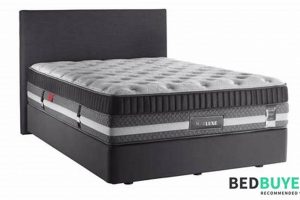A sleep surface specifically engineered to alleviate discomfort in the pelvic and upper torso regions can significantly improve rest quality. These mattresses are designed to minimize pressure points that commonly exacerbate aches and stiffness experienced by individuals with musculoskeletal issues in those areas. The selection of appropriate materials and construction techniques is crucial for achieving optimal pressure relief and spinal alignment.
The implementation of such mattresses offers numerous advantages, including reduced tossing and turning, improved blood circulation, and enhanced sleep duration. Historically, innovations in mattress technology have consistently sought to address prevalent sleep-related ailments. Early mattresses often lacked the ergonomic considerations necessary to mitigate pain effectively. Modern designs, however, incorporate advanced materials like memory foam and latex, along with zoned support systems, to target specific areas of the body.
The subsequent discussion will delve into the key factors to consider when selecting a mattress designed for pain reduction, including material types, firmness levels, and support technologies. Furthermore, the analysis will examine the impact of sleeping position and individual body weight on mattress suitability, offering a detailed guide to informed decision-making.
Selection Guidance
Selecting a sleep surface conducive to mitigating discomfort requires careful consideration of several factors. Prioritizing informed choices can significantly impact sleep quality and pain management.
Tip 1: Evaluate Material Composition: Memory foam conforms to the body’s contours, distributing weight evenly and reducing pressure points. Latex offers a responsive and durable alternative, providing both support and comfort. Hybrid mattresses combine the benefits of both materials, often incorporating innerspring coils for enhanced support.
Tip 2: Determine Optimal Firmness: Firmness is subjective and depends on individual weight, sleeping position, and pain sensitivity. Individuals with hip and shoulder pain may benefit from a medium-firm mattress that provides adequate support while allowing for some contouring.
Tip 3: Consider Zoned Support: Mattresses with zoned support feature varying levels of firmness across different areas. This design allows for targeted support to the hips and shoulders, promoting spinal alignment and reducing pressure.
Tip 4: Assess Edge Support: Strong edge support prevents the mattress from sagging along the perimeter, providing a stable surface for getting in and out of bed and maximizing usable sleep space.
Tip 5: Research Trial Periods and Warranties: Reputable mattress manufacturers offer trial periods, allowing individuals to test the mattress at home and return it if it does not meet their needs. A comprehensive warranty provides protection against defects and premature wear.
Tip 6: Prioritize Spinal Alignment: The selected mattress should promote proper spinal alignment in the preferred sleeping position. Side sleepers typically require a softer surface to accommodate the shoulders and hips, while back sleepers may benefit from a firmer mattress.
Tip 7: Account for Body Weight: Individuals with higher body weights generally require a firmer mattress to prevent excessive sinking and maintain spinal alignment.
Adhering to these guidelines facilitates a more informed decision, increasing the likelihood of selecting a sleep surface that effectively reduces pain and promotes restful sleep.
The subsequent section will provide a detailed overview of specific mattress types and their suitability for individuals experiencing hip and shoulder discomfort.
1. Pressure Relief
Pressure relief is a critical factor in selecting a sleep surface for individuals experiencing hip and shoulder discomfort. Mattresses designed to minimize pressure points can significantly reduce pain and improve sleep quality. The degree of pressure relief offered by a mattress directly impacts the musculoskeletal system, especially in vulnerable areas such as the hips and shoulders.
- Conforming Materials and Weight Distribution
Conforming materials, such as memory foam and certain types of latex, adapt to the body’s contours, distributing weight more evenly across the mattress surface. This reduces concentrated pressure on the hips and shoulders, which can cause pain and discomfort. For example, a side sleeper might experience significant hip and shoulder pain on a firm mattress that does not allow for adequate sinkage, leading to pressure buildup. A conforming mattress mitigates this by cradling these areas.
- Surface Area and Pressure Reduction
Increasing the surface area of contact between the body and the mattress reduces pressure per unit area. This principle is fundamental to pressure relief. A mattress that allows the hips and shoulders to sink slightly, increasing the contact area, can significantly lower the stress on these joints. This is particularly important for individuals with conditions like bursitis or arthritis, where pressure exacerbates inflammation.
- Influence on Blood Circulation
Sustained pressure on any part of the body can impede blood circulation, leading to discomfort and even pain. Effective pressure relief promotes healthy blood flow by minimizing constriction of blood vessels. Mattresses that offer superior pressure relief help maintain adequate circulation in the hips and shoulders, contributing to a more comfortable and restful sleep experience. Poor circulation can cause restless sleep and increased pain sensitivity.
- Prevention of Muscle Tension and Stiffness
Unrelieved pressure can lead to muscle tension and stiffness, particularly in the shoulders and hips. By minimizing pressure points, a well-designed mattress allows muscles to relax and recover during sleep. This is crucial for preventing morning stiffness and reducing chronic pain. For example, a mattress that evenly supports the body’s weight can prevent the muscles around the hip joint from becoming strained and tense overnight.
The principles of pressure relief are fundamental to the design and selection of mattresses intended to alleviate hip and shoulder pain. Selecting a mattress that prioritizes these aspects can offer significant therapeutic benefits, improving sleep quality and overall well-being. The interplay between materials, surface area, circulation, and muscle relaxation underscores the complexity of pressure relief and its impact on musculoskeletal health during sleep.
2. Spinal Alignment
Maintaining proper spinal alignment during sleep is paramount for individuals seeking relief from hip and shoulder p
ain. A mattress that supports the natural curvature of the spine minimizes stress on joints and muscles, contributing to a more restful and therapeutic sleep experience.
- Neutral Spinal Posture
The objective is to maintain the spine in a neutral position, mirroring its natural alignment when standing upright. This minimizes strain on the intervertebral discs and surrounding tissues. A mattress that is too firm can prevent the shoulders and hips from sinking sufficiently, leading to spinal misalignment for side sleepers. Conversely, a mattress that is too soft may allow excessive sinking, causing the spine to curve unnaturally. In both cases, the resulting misalignment can exacerbate pain.
- Pressure Distribution and Joint Support
Proper spinal alignment facilitates even distribution of pressure across the body, reducing stress on specific joints, including the hips and shoulders. When the spine is aligned, the body’s weight is more evenly supported, minimizing pressure points that can lead to pain and discomfort. A mattress that adequately supports the lumbar region, for example, prevents the hips from sinking excessively, maintaining alignment and reducing hip strain.
- Muscle Relaxation and Reduced Tension
Maintaining proper spinal alignment promotes muscle relaxation, reducing tension and stiffness throughout the body. When the spine is misaligned, muscles must work harder to compensate, leading to fatigue and discomfort. A mattress that supports spinal alignment allows muscles to relax fully, promoting blood flow and reducing inflammation. This is particularly beneficial for individuals with chronic pain conditions affecting the hips and shoulders.
- Sleeping Position Considerations
Spinal alignment needs vary depending on the preferred sleeping position. Side sleepers typically require a mattress that allows the shoulders and hips to sink sufficiently to maintain a straight spine. Back sleepers may benefit from a slightly firmer mattress that supports the natural arch of the lower back. Stomach sleeping is generally discouraged due to the difficulty of maintaining proper spinal alignment in this position. Selecting a mattress that accommodates the individual’s sleeping position is crucial for achieving optimal spinal alignment.
The interplay between spinal alignment, sleeping position, and mattress selection is central to managing hip and shoulder pain effectively. Prioritizing a sleep surface that promotes neutral spinal posture, distributes pressure evenly, and supports muscle relaxation can significantly improve sleep quality and reduce discomfort for individuals with these conditions.
3. Material Composition
The constituent materials of a sleep surface significantly influence its suitability for individuals experiencing hip and shoulder discomfort. The composition dictates pressure relief, support characteristics, and overall durability, factors directly affecting sleep quality and pain management.
- Memory Foam Properties
Memory foam, composed of viscoelastic polyurethane foam, conforms to the body’s contours, distributing weight and reducing pressure points. Higher-density memory foam provides enhanced support and durability, while lower-density options offer greater initial softness. In the context of hip and shoulder pain, memory foam can alleviate pressure on affected joints by allowing them to sink into the material, promoting spinal alignment for side sleepers. However, its heat retention properties may pose a challenge for some individuals, necessitating cooling technologies.
- Latex Characteristics
Latex, derived from rubber trees, exhibits resilience and responsiveness, providing both support and pressure relief. Dunlop latex is denser and firmer, offering robust support, while Talalay latex is lighter and more breathable. For individuals with hip and shoulder pain, latex provides a supportive yet cushioning surface, promoting spinal alignment and reducing pressure without the deep sink of memory foam. Its natural origin often appeals to those seeking eco-friendly options.
- Innerspring Coil Systems
Innerspring coil systems provide foundational support and contribute to airflow within the mattress. Coil gauge and configuration impact firmness and support levels. Pocketed coils, individually wrapped in fabric, minimize motion transfer, beneficial for couples. While innerspring systems offer robust support, their ability to alleviate pressure points depends on the comfort layers above them. Hybrid mattresses combine innerspring systems with memory foam or latex to achieve a balance of support and pressure relief suitable for hip and shoulder pain.
- Hybrid Construction Benefits
Hybrid mattresses integrate various materials to leverage their respective strengths. Typically, they combine an innerspring system with layers of memory foam or latex. This configuration offers a balance of support, pressure relief, and temperature regulation. For individuals with hip and shoulder pain, a hybrid mattress can provide the contouring of memory foam or latex to alleviate pressure points while maintaining the support of an innerspring system for proper spinal alignment. This combination addresses multiple factors contributing to sleep comfort and pain reduction.
The selection of mattress materials should be guided by individual preferences, sleeping positions, and specific pain-related needs. An understanding of the properties and interactions of these materials is crucial for making an informed decision that optimizes comfort and support, ultimately contributing to improved sleep and reduced hip and shoulder pain.
4. Firmness Level
Firmness level exerts a direct influence on pressure distribution and spinal alignment, factors critical to mitigating hip and shoulder pain. The appropriateness of a mattress’s firmness is not universal; it is contingent upon individual body weight, sleeping position, and specific anatomical considerations. A mattress deemed too firm may fail to conform to the body’s contours, creating pressure points on the hips and shoulders, thus exacerbating existing pain. Conversely, a mattress that lacks sufficient firmness may allow excessive sinking, leading to spinal misalignment and subsequent discomfort in the same areas. The interaction between these factors is a significant determinant of sleep quality and pain management.
For example, a side sleeper with a higher body mass index may require a firmer mattress to prevent excessive compression of the shoulder and hip into the sleep surface, ensuring the spine remains horizontally aligned. A lighter individual, however, may find the same firmness level too rigid, leading to pressure buildup. Similarly, a back sleeper may benefit from a medium-firm mattress that provides adequate support for the lumbar region, preventing the hips from sinking too deeply and maintaining natural spinal curvature. Practical application of this understanding involves carefully assessing individual needs and preferences, potentially through trial periods offered by mattress retailers. Furthermore, consulting with a healthcare professional may provide valuable insights into selecting a firmness level that aligns with specific medical conditions.
In summary, firmness level is an integral component of selecting
a sleep surface intended to alleviate hip and shoulder pain. Its significance lies in its capacity to influence pressure distribution and spinal alignment, both of which directly impact comfort and pain levels. While the optimal firmness level is highly individualized, understanding the interplay between body weight, sleeping position, and anatomical considerations is essential for making an informed decision. The challenges associated with firmness selection underscore the importance of thorough research and, when possible, practical testing to ensure the chosen mattress effectively addresses individual needs.
5. Support System
The support system within a sleep surface directly impacts its efficacy in alleviating hip and shoulder pain. The primary function of this system is to maintain spinal alignment and distribute body weight evenly, preventing the concentration of pressure on sensitive joints. Without adequate support, the spine may deviate from its natural curvature, leading to muscle strain and exacerbation of existing pain conditions. Innerspring coils, foam cores, and hybrid constructions serve as support systems, each offering varying degrees of firmness and contouring. For instance, a pocketed coil system can independently adjust to pressure, providing targeted support to the lumbar region and preventing the hips from sinking excessively, thereby minimizing strain. The choice of support system is thus a critical determinant of a mattress’s ability to reduce hip and shoulder pain effectively.
The practical application of this understanding is evident in the design of mattresses specifically marketed for orthopedic support. These often incorporate zoned support systems, where the firmness varies across different areas of the mattress to accommodate different body regions. A firmer zone beneath the hips, for example, prevents sinking, while a softer zone beneath the shoulders allows for comfortable compression. This approach addresses the unique support requirements of different body areas, promoting proper spinal alignment and reducing pressure points. Furthermore, the durability of the support system is paramount. A sagging or degrading support system can negate the benefits of even the most advanced comfort layers, rendering the mattress ineffective in alleviating pain. Therefore, selecting a mattress with a robust and durable support system is a key consideration.
In conclusion, the support system is a fundamental component of any mattress designed to mitigate hip and shoulder pain. Its ability to maintain spinal alignment, distribute weight, and provide targeted support directly influences comfort and pain levels. While the optimal choice of support system depends on individual preferences and body characteristics, prioritizing a durable and well-designed system is essential. Failure to address the support system’s role may result in a mattress that, despite other beneficial features, ultimately fails to provide adequate pain relief, thereby underscoring the importance of this seemingly understated aspect.
6. Motion Isolation
Motion isolation refers to a mattress’s ability to minimize the transfer of movement across its surface. This is a crucial characteristic for individuals experiencing hip and shoulder pain, particularly if they share a bed. Disrupted sleep due to a partner’s tossing and turning can exacerbate pain symptoms, hinder the body’s natural healing processes, and reduce overall sleep quality. A mattress that effectively isolates motion prevents these disturbances, allowing the individual to remain undisturbed and maintain a more consistent sleep cycle. The link between motion isolation and effective pain management is thus a direct one: improved sleep facilitates physical recovery.
Mattresses constructed with materials such as memory foam or pocketed coils typically exhibit superior motion isolation capabilities. Memory foam absorbs movement at the point of impact, preventing it from spreading across the mattress surface. Pocketed coils, where each spring is individually wrapped, further minimize motion transfer by allowing coils to respond independently to pressure. In contrast, mattresses with interconnected coil systems tend to transmit movement more readily. Real-life examples include couples where one partner has chronic hip or shoulder pain. With a mattress lacking good motion isolation, the partner’s movements frequently awaken the individual in pain, leading to fragmented sleep and increased pain sensitivity the following day. However, switching to a mattress with excellent motion isolation often leads to a noticeable improvement in sleep quality and a reduction in reported pain levels.
Therefore, when selecting a mattress for hip and shoulder pain, motion isolation should be considered a significant attribute, especially if the bed is shared. Understanding the construction and materials that contribute to effective motion isolation is essential for making an informed decision. Although other factors such as firmness and support also play crucial roles, motion isolation contributes significantly to creating a sleep environment conducive to rest and healing. Failure to consider this aspect may undermine the benefits derived from other desirable mattress features, leading to persistent sleep disturbances and continued pain.
7. Temperature Regulation
Temperature regulation in mattresses is a crucial, though often overlooked, factor when selecting a sleep surface intended to alleviate hip and shoulder pain. An excessively warm sleep environment can disrupt sleep cycles, increase inflammation, and exacerbate pain symptoms, while a too-cool environment can lead to muscle stiffness and discomfort. The ability of a mattress to maintain a neutral thermal state is thus intrinsically linked to its capacity to facilitate restorative sleep and reduce pain.
- Material Breathability and Airflow
Materials with enhanced breathability, such as open-cell memory foam, latex with pinholes, and coil-based innerspring systems, promote airflow and dissipate heat. Conversely, closed-cell memory foam and dense, non-breathable fabrics can trap heat, leading to overheating. For individuals with inflammatory conditions contributing to hip and shoulder pain, maintaining a cool sleep environment is paramount. Mattresses incorporating breathable materials can help prevent nocturnal temperature spikes, reducing discomfort and promoting deeper sleep. For example, a mattress combining a pocketed coil system with a layer of Talalay latex allows for both support and enhanced airflow, mitigating heat buildup.
- Moisture Wicking Properties
The ability of a mattress to wick away moisture is essential for temperature regulation and hygiene. Materials such as wool and certain synthetic fabrics possess inherent moisture-wicking properties, drawing sweat away from the body and preventing it from accumulating in the mattress. This is particularly beneficial for individuals who experience night sweats or live in humid climates. A mattress with effective moisture wicking can help maintain a dry and comfortable sleep environment, reducing the likelihood of skin irritation and preventing the proliferation of bacteria. In practice, mattresses with wool-blend covers or
moisture-wicking fabrics often provide a cooler and drier sleep surface than those with synthetic covers. - Cooling Technologies
Advanced cooling technologies, such as gel-infused memory foam, phase change materials, and active cooling systems, are designed to actively regulate temperature. Gel-infused memory foam incorporates gel particles that absorb and dissipate heat, while phase change materials adapt to the body’s temperature, providing cooling when the sleeper is warm and warmth when the sleeper is cool. Active cooling systems, though less common, utilize fans or water circulation to actively regulate temperature. For individuals with conditions such as arthritis, where heat can exacerbate joint pain, a mattress with effective cooling technologies can provide significant relief. One practical example is gel-infused memory foam, helping to maintain a stable, comfortable temperature throughout the night.
- Cover Fabric Selection
The cover fabric of a mattress plays a significant role in its overall temperature regulation. Natural fibers, such as cotton, linen, and bamboo, are generally more breathable and moisture-wicking than synthetic fibers. Tightly woven fabrics tend to trap heat, while loosely woven fabrics promote airflow. Selecting a mattress with a cover made from breathable natural fibers can significantly improve temperature regulation and enhance sleep comfort. For example, a mattress with a bamboo-derived rayon cover may feel cooler and more comfortable than one with a polyester cover, particularly in warm environments.
The importance of temperature regulation should not be underestimated when selecting a mattress intended to alleviate hip and shoulder pain. A sleep surface that effectively manages temperature can promote deeper, more restful sleep, reduce inflammation, and minimize discomfort. While individual preferences vary, prioritizing materials, technologies, and construction methods that enhance breathability, moisture wicking, and active cooling can significantly improve the sleep experience and contribute to improved pain management. The integration of these considerations underscores the complexity of selecting a suitable mattress and highlights the interconnectedness of various factors influencing sleep quality.
Frequently Asked Questions
This section addresses common inquiries regarding the selection of mattresses intended to alleviate hip and shoulder pain, providing concise and informative responses.
Question 1: Is a firmer mattress always better for individuals with hip and shoulder pain?
No. While firmness can provide support, a mattress that is too firm may exacerbate pressure points on the hips and shoulders, leading to increased pain. The optimal firmness level is dependent on body weight, sleeping position, and individual pain sensitivity.
Question 2: How does memory foam contribute to pain relief in mattresses?
Memory foam conforms to the body’s contours, distributing weight evenly and reducing pressure on the hips and shoulders. This contouring can alleviate stress on joints and promote spinal alignment, leading to reduced pain and improved comfort.
Question 3: Are innerspring mattresses suitable for individuals with hip and shoulder pain?
Innerspring mattresses can provide support, but their suitability depends on the comfort layers. A thick comfort layer of memory foam or latex can mitigate pressure points, making an innerspring mattress a viable option. However, an innerspring mattress with minimal comfort layers may not provide sufficient pressure relief.
Question 4: What role does sleeping position play in selecting a mattress for hip and shoulder pain?
Sleeping position significantly impacts mattress selection. Side sleepers typically require a softer mattress to allow the shoulders and hips to sink in, maintaining spinal alignment. Back sleepers may benefit from a medium-firm mattress, while stomach sleeping is generally discouraged due to its tendency to misalign the spine.
Question 5: How important is motion isolation for individuals with hip and shoulder pain?
Motion isolation is crucial, particularly for those sharing a bed. Disruptions caused by a partner’s movements can exacerbate pain and disrupt sleep cycles. Mattresses with good motion isolation minimize the transfer of movement, promoting undisturbed rest.
Question 6: What is the significance of temperature regulation in mattresses designed for pain relief?
Temperature regulation is essential for maintaining a comfortable sleep environment. Overheating can disrupt sleep and increase inflammation. Mattresses with breathable materials and cooling technologies help regulate temperature, promoting restful sleep and reducing pain.
In essence, selecting a mattress for hip and shoulder pain requires careful consideration of firmness, material composition, sleeping position, motion isolation, and temperature regulation. An informed decision, tailored to individual needs, can significantly improve sleep quality and reduce pain levels.
The subsequent section will offer practical tips for optimizing the sleep environment to further alleviate hip and shoulder discomfort.
Conclusion
The preceding analysis has underscored the multi-faceted considerations essential in selecting a suitable sleep surface for individuals experiencing hip and shoulder pain. Key factors such as pressure relief, spinal alignment, material composition, firmness level, support system, motion isolation, and temperature regulation have been explored. A comprehension of these interconnected elements is paramount in making informed decisions regarding the selection of the best mattress for hip and shoulder pain.
The pursuit of optimal sleep and pain management necessitates a personalized approach, factoring in individual preferences, body characteristics, and specific medical conditions. While general guidelines can provide direction, practical evaluation and, when feasible, professional consultation are advisable. Prioritizing these considerations can significantly improve sleep quality, reduce pain, and enhance overall well-being. Continued advancements in sleep technology promise further innovations in mattress design, offering potential for even greater comfort and therapeutic benefits in the future.


![Top-Rated: Choosing the Best Mattress Foundation [Guide] Organic & Natural Mattress Buyer’s Guide: Non-Toxic Sleep Solutions Top-Rated: Choosing the Best Mattress Foundation [Guide] | Organic & Natural Mattress Buyer’s Guide: Non-Toxic Sleep Solutions](https://mattressworldpa.com/wp-content/uploads/2025/07/th-7633-300x200.jpg)




![How to Find the Best Way Twin Air Mattress [Guide] Organic & Natural Mattress Buyer’s Guide: Non-Toxic Sleep Solutions How to Find the Best Way Twin Air Mattress [Guide] | Organic & Natural Mattress Buyer’s Guide: Non-Toxic Sleep Solutions](https://mattressworldpa.com/wp-content/uploads/2025/07/th-7628-300x200.jpg)